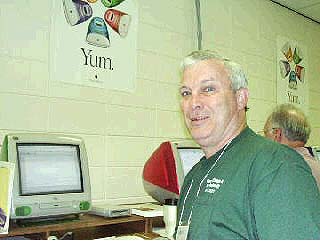SCSI ADVANCED SESSION
JULY 16-22, 2000

TEAM MEMBER
Hugh Sanders
Department of Mathematics and Computational Science
SCSI ADVANCED SESSION
JULY 16-22, 2000

TEAM MEMBER
Hugh Sanders
Department of Mathematics and Computational Science
I wanted to expand on my previous experience with Stella and Simulink. I had used these to solve a system of five differential equations to solve a problem about pollution in the Great Lakes. Also, I had used Stella to solve a predator-prey problem involving one predator and one prey in a Lotka-Volterra model.
It was suggested that a predator-prey problem involving more species would be a good problem. So, I decided to look at a problem involving six species with different predator-prey characteristics. I had bears which would kill and consume deer and fish and kill wolves, wolves killing and consuming deer, birds killing and consuming fish, and deer eating vegetation. I used Lotka-Volterra-type equations with the exception that the vegetation grew at a constant rate. Based on these equations I set up a Stella model.
To get started selecting values for constants and initial values, I used values in line with an example of a Lotka-Volterra system that I saw in a textbook. I, then, tried to change these values to get a steady-state condition with as many species surviving as possible. The largest number of survivors that I could get was a situation where there were five species surviving in a steady-state condition with one species dying out.
After doing this with Stella, I then tried to represent this system using Simulink. To do the Simulink representation I integrated each of the six differential equations in my system. This allowed me a way to set up the system in Simulink. It gave the same results. I could probably have used the original equations, but I am not familiar with using that type of equation in Simulink.
I would like to continue exploring this problem using other population representations in addition to Lotka-Volterra. Also, the Shodor staff was very helpful in assisting me in doing this project.